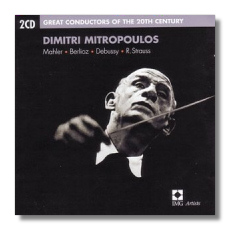
The Internet's Premier Classical Music Source
Related Links
- Latest Reviews
- More Reviews
-
By Composer
-
Collections
DVD & Blu-ray
Books
Concert Reviews
Articles/Interviews
Software
Audio
Search Amazon
Recommended Links
Site News
 CD Review
CD Review
Great Conductors of the 20th Century

- Gustav Mahler: Symphony #6 "Tragic" *
- Hector Berlioz: Roméo et Juliette: excerpts
- Claude Debussy: La Mer
- Richard Strauss: Salome: Dance of the Seven Veils
* WDR Symphony Orchestra, Köln/Dimitri Mitropoulos
New York Philharmonic Orchestra/Dimitri Mitropoulos
EMI Classics 5 75471 ADD monaural 2CDs: 74:32, 78:18


- François Auber: Fra Diavolo: Overture
- Antonín Dvořák: Symphony #8
- Claude Debussy: La Mer *
- Frederick Delius: Irmelin: Prelude
- Gioachino Rossini: L'Italiana in Algeri: Overture
- Piotr Ilyitch Tchaikovsky: Symphony #5 *
- Richard Wagner: Overture "Die Meistersinger von Nürnberg" **
- Josef Strauss: Delirien
Cleveland Orchestra/George Szell
* WDR Symphony Orchestra/George Szell
** New York Philharmonic Orchestra/George Szell
EMI Classics 5 75962 ADD monaural/stereo 2CDs: 72:55, 72:36


- Ambroise Thomas: Overture "Mignon"
- Franz Schubert: Symphony #6
- Johannes Brahms: Symphony #2
- Otto Nicolai: Overture "The Merry Wives of Windsor"
- Richard Strauss: Don Juan
- Nicolai Rimsky-Korsakoff: Schéhérazade
- Edward Elgar: Cockaigne (In London Town) *
Concertgebouw Orchestra/Eduard Van Beinum
* London Philharmonic Orchestra/Eduard Van Beinum
EMI Classics 5 75941 ADD monaural 2CDs: 75:43, 78:54
Collaboration between EMI Classics and IMG Artists has led to the creation of Great Conductors of the 20th Century, a series devoted to some of the great (and late) conductors of the previous century. By working with other labels, EMI and IMG have been able to dig deep and to bring many unusual recordings forward, some of them live. Many have not appeared on CD until now.
Religious metaphors sometimes are used to describe Dimitri Mitropoulos; William Trotter's biography of the conductor is titled Priest of Music. Mitropoulos, who was born in Athens in 1896, spent much of his professional career conducting orchestras in the United States: the Minneapolis Symphony Orchestra (happily) and the New York Philharmonic (less happily, mostly for the "sin" of being neither Bruno Walter nor Leonard Bernstein). He was a friend to young composers, and he championed music that most conductors didn't look twice at during the 1940s and 50s. He led an ascetic lifestyle and almost literally gave the shirt off his back to help those who were less fortunate than he. He seemed to channel all his physical drives into his conducting, and his interpretations were intense, taut, and red-hot. He had a keen ear, but he was not particularly concerned with technical perfection, and so the New York musicians took advantage of him and the critics sneered. He died of a massive heart attack in 1960 while rehearsing Mahler's Third Symphony in Milan.
Mitropoulos's only commercial Mahler recording was of the First Symphony (with Minneapolis), but there are concert and broadcast recordings of all the other completed symphonies, save the "Resurrection." The Sixth offered here is a live recording from 1959, and superior to the New York performance most people know. Even though there are plenty of flubs and clams from the German musicians, the performance is as powerful as it is intensely personal. (The exposition repeat in the first movement is not taken.) The three remaining items are recordings from Columbia Records' 30 Street studios. The Berlioz, recorded in 1952, is almost hallucinatory, and I think it gives Toscanini more than a run for his money; too bad Mitropoulos didn't record the whole thing. The Debussy, from 1950, is obsessive and emotional. Salome's veils are removed with almost pornographic naughtiness in a studio reading from 1956. Mitropoulos, who appears to have led a largely celibate lifestyle, nevertheless seems to have known enough about love and lust to portray them unforgettably in music.
The differences between Dimitri Mitropoulos and George Szell are striking. The Budapest-born Szell was a notorious perfectionist, and he could wilt an erring orchestral player with a few choicely sarcastic words. (If memory serves, an account of his relationship with the Cleveland Orchestra was called "one hundred men and a louse.") Temperamentally, he was like Star Trek's Mister Spock: cool and logical. He had little sympathy for music written during the second half of the twentieth century; Walton and Barber were two exceptions. Nevertheless, they had their similarities. Both raised the playing standards of less than first-class orchestras – Mitropoulos in Minneapolis and Szell in Cleveland. As opera conductors, both were under-recognized (at least at the time). While Szell not was often an overtly emotional conductor, he, like Mitropoulos, could whip musicians into a fury of excitement, as can be heard in the two live studio recordings with the WDR Symphony Orchestra (Debussy, Tchaikovsky) offered here.
Because Szell recorded both La Mer and Tchaikovsky's Fifth commercially in Cleveland, I was surprised that EMI opted to issue performances with the somewhat inferior German orchestra. The Cleveland readings certainly are more refined, more typical of Szell's obsessive honing of details. Nevertheless, these German performances reveal a certain wildness in Szell, and this will be unfamiliar to those like me who have known only his American records. But to turn things around, I think Szell's earlier Epic recording of the Dvořák Eighth is more spontaneous, more authentically Bohemian than the darker EMI recording selected here. (It was taped in 1970, the year of the conductor's death.)
The remaining works are more lightweight fare, and even though Szell didn't have a particularly congenial personality, the Auber swaggers cutely, the Rossini giggles, and the Strauss is truly delirious. Szell's Delius is as unexpected as it is convincing – no gauziness here.
Next to Mitropoulos and Szell, one might be forgiven for remarking that Eduard Van Beinum had no personality at all. This would be unfair, however. Van Beinum was one of those conductors who seldom called attention to himself, yet who consistently turned out recordings that one could "live with" like comfortable furniture and familiar housepets. Nothing flashy or fancy here, just great musicianship.
Born in Holland in 1900, he studied at the Amsterdam Conservatory, and by 1927 he was conducting a professional orchestra in Haarlem. In 1938, he was given a position (behind Willem Mengelberg) with the Concertgebouw Orchestra. After World War Two and Mengelberg's subsequent political disgrace, Van Beinum became the orchestra's principal conductor. He died in 1959, and was succeeded by another low-key but effective conductor, Bernard Haitink. Van Beinum also held posts in Los Angeles and with the London Philharmonic.
Most of Van Beinum's recordings were made for the Philips label. Several of the best ones are represented here, including an exciting yet always controlled Schéhérazade, a beautifully proportioned Schubert Sixth, and the overtures by Thomas and Nicolai. The conductor's unexpected affinity for English music is demonstrated by Cockaigne. (Recorded in 1949, this is the oldest recording here.) The Brahms and the Strauss are live recordings from Stuttgart on September 16, 1955. The playing of the Concertgebouw Orchestra is a little disheveled here; when Van Beinum recorded a superior Brahms Second in the studios, it is hard to explain why a live version was chosen instead. It's not a major disappointment, but there's better to be had. Still, this set, like others in the series, reminds us that sometimes records lie. What you hear in the concert hall is not the same as what you can hear in a studio recording, when numerous opportunities to retake and to "groom" the sound are available.
Copyright © 2003, Raymond Tuttle


















